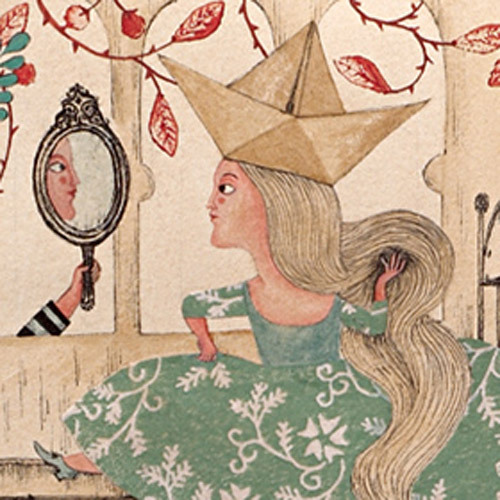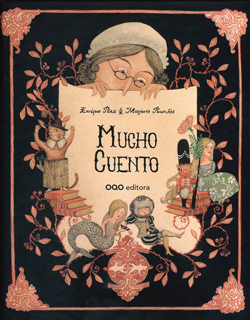< Back to posts
Marjorie Pourchet
France

Marjorie Pourchet studied illustration with Claude Lapointe at the School of Decorative Arts in Strasbourg. After graduating, she wrote and illustrated ‘La tête dans le sac’, which was selected for the 23rd Mostra d'Illustration in Sarmede. Since then, she's illustrated books for publishers such as Sarbacane, Rouergue, Actes Sud and OQO.
In this post, Marjorie shares some beautiful illustrations and talks about her working process on ‘Mucho Cuento’ (Many Tales). This inventive picturebook, which was written by Enrique Páez and published by OQO Editora, is a celebration of fairy tales.
Marjorie: When OQO Editora offered me ‘Mucho Cuento’, I was immediately interested in the recursive nature of the book within a book. It was an opportunity for me to seize characters from classic fairy tales, and to plunge (once again) into the references and codes of the genre, and to play with them.
Up until that point, I hadn't been asked to illustrate many fairy tales. But of course, I was inhabited by strong iconographic references which guided me in my research for this book: the engravings of Gustav Doré (I allowed myself a wink at one of his cover compositions to create my own), Bilibin, illuminations, books of spells, the yellowed pages with baroque ornaments crimping the illustrations in the earliest illustrated books... I had in mind an ageless storybook, somewhat magical, which would provide me with a narrative space.
In general, I see myself as a sort of stage director; my characters are my actors, and they can play many parts, from one story to another, depending on how I dress them up, apply makeup on them and style their hair... They are always somewhat alike; they all look a little like one another (almost in spite of myself). I lend them a life outside the book, and I'm satisfied with my craft when I come to believe they exist.
So this idea of characters who step outside books immediately appealed to me. The double meaning of the original title (in Spanish, I've been told that ‘Mucho Cuento’ literally means ‘Many Tales’, but it's also an expression often used for anyone who play-acts and makes up lots of stories) served to guide my efforts.
The difficulty for me was in selecting from all these references, between all these fairy tale characters who I wished to conjure as a whole, and who I imagined to be one big family... I had to make certain choices for the sake of clarity, measure what I would present explicitly against what I would leave to the reader's imagination, since my goal was that several narrative spaces would co-exist:
- Sleeping Beauty's bedroom was to be the backdrop of a scene where the characters play out and reinvent their stories.
- The storybook would be the stage.
- The library would bring us back to the space of reality.
The ornate picture frame, inspired by old illustrated books, would be the gateway from one space into another: from the inside of the book to the outside, from the text to the image, from one side of the mirror to the other. It would be the connecting thread, guiding you to the outcome of the story, to the final recursion. The librarian is a sort of magician who has access to this gateway and to this small world inside books: a sort of mother to all the characters who make up stories for themselves, like children do when they don't want to go to sleep, absorbed by their game.
My creative process is substantially the same in each of my books: I draw a lot of sketches (maybe too many!) in order to carry out the ‘casting’ of the characters, and I think of all possible postures, scopes, allusions. This is generally rapid note-taking, with aesthetics not yet taken into account. Next, I hang them all around me and I try to reorganise them, so that I may find what will provide me with the tracks of a railway that will link the pages. Only after all of that is in place can I look into the implementation of the colour rendition that I have in mind.
Technically, in several of my books, there is reference to engraving. Here, this graphical tribute (to the first technique for the reproduction of illustrations) seemed to me to make perfect sense, since I referred to the portrayal of old books. In addition to quill work made in the style of drypoint, I used linocuts for certain recurring motifs, such as the famous ornate picture frame, trees, patterns in dresses... This is also a more playful approach to the colouring process.
I love to work on little details and I can spend a very, very long time on a single illustration. So I always try to remind myself how important it is not to lose the sense of play, so that the end result doesn’t end up strained. Also, my colour work was done in a lighter way than before, using inks rather than acrylic paint. I noticed that this has developed my drawing, especially my characters.
The graphical experiments put to use in this book are still being used in my current projects. I've built some little graphic tools for myself, which I feel can offer me lots of possibilities.
Illustrations © Marjorie Pourchet. Post translated by Gengo and edited by dPICTUS.
Mucho Cuento / Many Tales
Enrique Páez & Marjorie Pourchet
OQO Editora, Spain, 2014
Sleeping Beauty is woken by a kiss. But instead of her charming prince, she opens her eyes to the Tin Soldier, who asks for her hand in marriage! Beauty discovers that while she'd been sleeping, Hansel married the ballerina, Prince Charming married the Little Mermaid, and Cinderella and Little Red Riding Hood moved into the woodcutter's hut and have the wolf as a pet!
‘Mucho Cuento’ (Many Tales) features several stories in one, and an endless stream of characters who appear and disappear, leaving new adventures in their wake.















